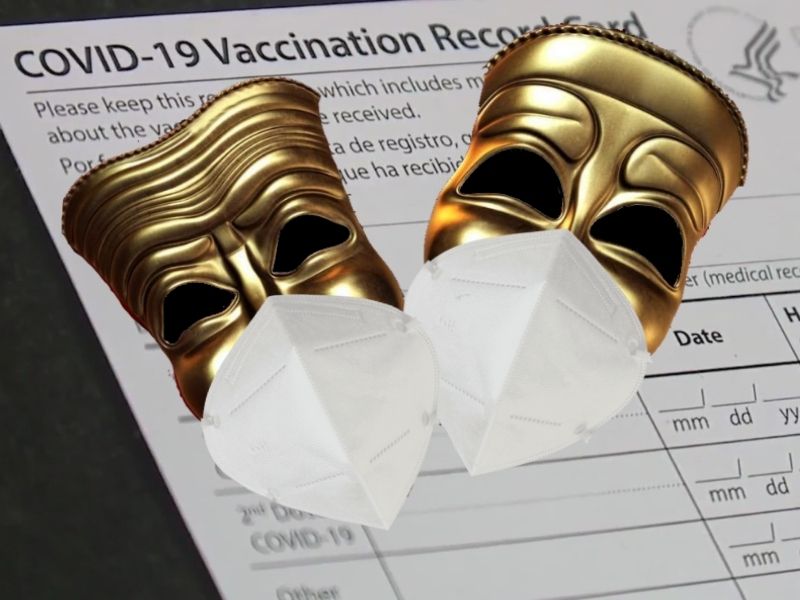On February 18, 2022, DCTMA published an editorial urging local theaters to exercise caution and restraint before lifting current mask and vaccine requirements for patrons. Even then, as case numbers declined from their omicron peak, there was widespread sentiment for people to be “done with COVID.” State and local governments across the country were already ending mitigation measures, a trend that has only accelerated in the weeks since.
To DC-area theaters: Be careful. Being swayed by the momentum of COVID safety-measure removal would be a mistake. There’s far more at stake here than consistency with government guidance or the overall public mood.

It is fair to say that the decision of almost all DC-area theater companies to install COVID safety requirements for performances, beginning last August, was the key to allowing theaters to resume live performances and persuading audiences to return. In January, that mask/vaccine-documentation policy was extended through March. (See the policy and the list of participating theaters, coordinated by Theater Washington, here.)
Why is this policy’s continuation important? First, to protect the health of everyone who attends or works in our theaters. Second, and equally important, to ensure the ability and willingness of audiences to attend live performances. The mask-and-vax policy remains crucial to the economic health and survival of DC-area theaters.
Third, COVID is far from over. We are seeing a lull in infections, not a reason to declare victory. Health authorities are concerned that another COVID surge could be coming. In several European countries, case numbers are climbing due to a subvariant of omicron known as BA.2. Relaxation of mitigation measures, like masking, may well be contributing to this resurgence. In the U.S., overall case numbers have been dropping, but BA.2 now accounts for a quarter of new cases. And ominously, the BA.2 subvariant is estimated to be 30 to 50 percent more contagious than the previous version of omicron. Given how viruses behave, and the reservoir of infections in parts of the world with low vaccination rates, BA.2 is unlikely to be the last variant we see.
Current CDC guidance concerning mask policies rests on hospitalization and death numbers — both lagging indicators — rather than numbers of infections. Infections can easily be gathering steam for three to four weeks before reaching CDC trigger points for changing mask policies. That would not be good for our theaters and audiences.
The existing policy has not deterred people from coming to the theater; quite the contrary, there is widespread support for it. Audience levels have remained strong in many venues. People and groups demanding “personal freedom” to ignore their safety and that of others have not been in evidence at theater performances.
A crucial point to remember is that theaters are different. Unlike many other indoor venues, theaters ask hundreds or even thousands of people to sit in close proximity for 90 minutes to three hours, an ideal setting for the circulation of an airborne virus, even among the fully vaccinated. Theater audiences tend to skew older; so in the absence of vaccine and mask precautions, it is likely that attendance would decline as people more susceptible to severe COVID complications decide to stay home.
Recently, Theatre Washington sent a survey to theater patrons asking their views about potential changes in current policies. We ask that organizations, and individual theaters, not treat public safety as a popularity contest. In theater policy as in medicine, first do no harm. Ending precautions, only to have to re-start them later as a new variant or wave emerges, has been a source of confusion throughout the pandemic. Theaters would be well advised to avoid the yo-yo effect that is a predictable outcome of prematurely ending the current policy.
In any re-evaluation of COVID policy, the important interests of theaters and theatergoers in safety, in the unique environment of live theater, must be respected by retaining the requirements that have protected all of us through the worst of the pandemic.
SEE ALSO: Will COVID safety protocols survive at local theaters? (report by Keith Loria)
(An earlier version of his editorial, titled “Now is no time for theaters to quit mask and vax requirements,” was published on February 18, 2022.)






The question becomes WHEN do theaters remove the mask mandate? I believe that saying masks should come off at the tail end of a surge is wildly irresponsible. Shouldn’t there be metrics that we meet? Wouldn’t that remove the emotion and lack of clear thinking from both sides in this debate? A recent NYTimes article with several epidemiologists said that when community transmission drops below 10 per 100,000 in a week, there is no need for indoor masking. Of course anyone can still wear a mask if they choose to do so. I worry that as society begins to drop masking requirements, theaters will continue to be an outlier even as movie theaters, concert venues and restaurants move on. As much as some would like others to mask forever, we need to start discussing the metrics that allow the masks to come off. We’ve been operating from a place of feelings and not a place of data.